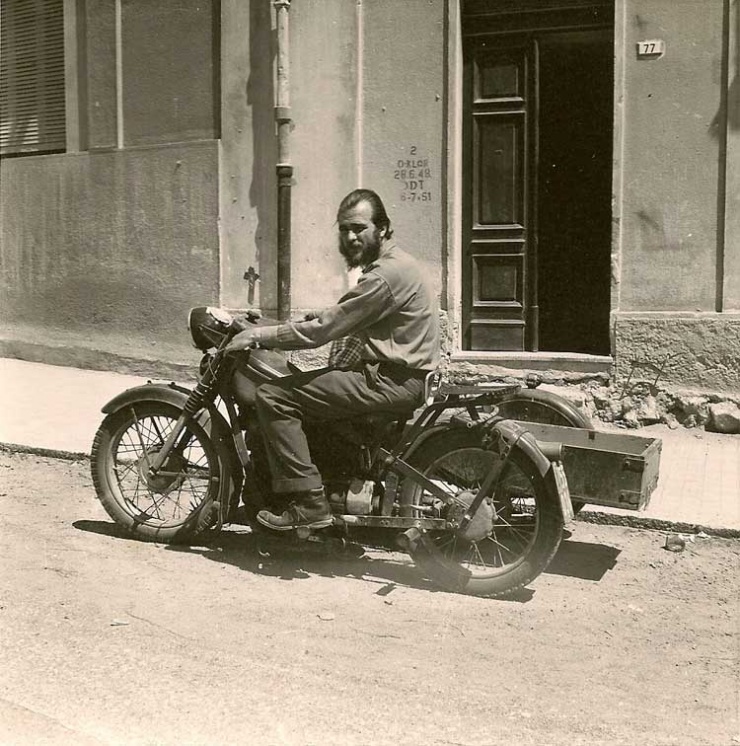Timeline
Timeline (PDF with Italian, Sardinian, English, Spanish, Danish versions)>
1936
Andreas Fridolin Weis Bentzon was born in Gentofte, on the outskirts of Copenhagen, from jurist and composer Jørge Bentzon, and from Michala Weis. He grew up in the village, displaying early talent and intelligence.
1952
He played the double bass and joined the "Adrian Bentzon's Jazz Band� founded by his brother Adrian, piano player, performing at the �Storyville� jazz-club near Copenhagen.
1953
First tourist journey to Sardinia, and first encounter with the world of Sardinian folk music and its instrument: launeddas.
1954
He continued to play jazz with his brother Adrian, who opened the Copenhagen jazz-club "Montmartre". He enrolled at the University of Copenhagen, registering for an Anthropology degree.
1955
Secondo trip to Sardinia: his interest for anthropology had become clearer, and he developed a real passion for the music of launeddas. With him were his girlfriend Ulla Ryum and a friend he met in Rome, Christian Ejlers, who would eventually become his future editor. They joined the small yet popular Circo Zanfretta, as animal carers, thus being able to travel and discover new places. He began to take and collect photographs.
1957
His scientific calling now mature, Andreas travelled to the island on his own, taking an adventurous journey on an old Nimbus motorcycle. He substituted the sidecar with a wooden crate containing his equipment. Between December 1957 and April 1958, he researched the launeddas, recording music and songs as well as researching the life of musicians, particularly in Cabras. He started purchasing ethnographic material on behalf of the National Danish Museum.

A.F.W. Bentzon riding his Nimbus, Sardinia 1958
1959
Using the material he had collected, he set up an ethnographic exhibition on Sardinia at the National Museum, hosted radio programmes on Sardinian music and held conferences for music students.
1962
Back in Sardinia, he continued his collection of folk music and poetry. With him were his wife Ruth and the Danish poet Jørge Sonne, who was charged with researching the metre of folk songs, but also turned out to be a skilled photographer. He began designing a joint project for the Universities of Copenhagen and Cagliari on the poetic culture of southern Sardinia. In those months he also began filming with a 16 mm camera, shooting 20 rolls of film, on which director Fiorenzo Serra later based his renowned documentary "Is Launeddas, the music of the Sardinians."
1963
He set up a Gamelan (Balinese) music band organizing concerts and writing many music scores and other material, currently held in Copenhagen's Folkemindesamling. He also continued his radio programme work in Denmark and Norway, and continued presenting his research on Folk culture at home and in Sardinia.
1964
He was awarded a degree in Anthropology, with the title of Magister Artium.
1965
Once he abandoned the joint project with the Danish Institute of Anthropology and the University of Cagliari, he focussed his research on the village of Nule , studying its social life and collecting an impressive amount of notes, recordings and photographs in his many journeys there.
1966
He was appointed Director of the Ethnographic Museum in Göteborg (Sweden). In Copenaghen, he became a Kandidatstipendiat (doctoral student) and later an Universitetsadjunkt (lecturer and researcher) at the Institute of Ethnology and Anthropologia, where he taught the Methodology course.
1969
He published "The Launeddas, a Sardinian Folk Music Instrument" (two volumes) in Copenaghen and on December 7th, he presented his research at the University's solemn graduation ceremony, obtaining the title of Doctor of Philosophy, the highest academic achievement in Denmark, and the first ever degree in Ethnomusicology in Denmark.
1971
He died in Gentofte, on December 19th, only 35 years of age.
|


